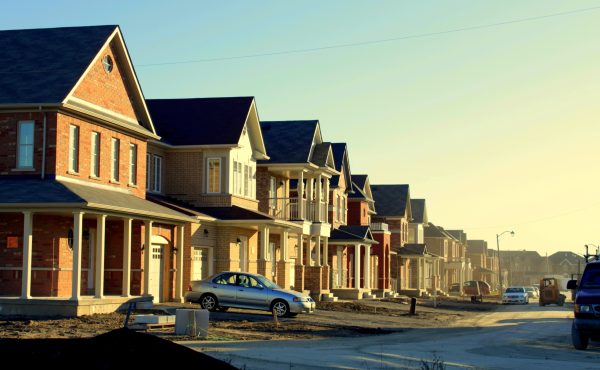
(Image of the Wyld-Darling building on Bay Street, after the 1904 fire — via Toronto Archives)
John Barber’s Globe column today, A city in decline? Truth be told, Toronto’s on a roll, is like civic prozac after a few months of hearing why Toronto is so crappy from various candidates. He suggests that “one reason there are so many urban myths — as opposed to the rural or small-town variety — is that urbanites are neurotic and suggestible. The longer the good times roll, the more acutely the average Torontonian senses impending catastrophe.” Toronto was never supposed to be great, so maybe some of us are just uncomfortable when the city is just that.
Of the myths he “busts,” three are particularly interesting:
Toronto is ugly. First, get out of the car. Second, open your eyes. Third, walk around. St. James Town would be a good place to start, because it perfectly embodies the urban-decorator idea of ugly. Not until it is gentrified will such judges recognize St. James Town as the monument it is: one of the largest, most radical and ultimately successful examples of high-density modernism, straight out of Le Corbusier, ever attempted outside Hong Kong. But by then the neighbourhood will have lost the soul it gained as an overcrowded immigrant reception centre, and it will be less attractive. So go now.
During the 1960s, Toronto realized it had a wonderful victorian heritage to celebrate and preserve — I think we’re slowly realizing the extent of Toronto Modernism is worth that interest too. Barber writes nice about St. James Town here (I often wonder if people who use St. James Town as their modernist/highrise scapegoat have ever actually walked through it). I would add Thorncliffe Park as another place to check out. We often keep an archetypal form of what a beautiful city should look like in our heads (either of the Parisian or New York variety, depending on your preference for the tall and phallic or the short and ornate kind of beauty) — but Toronto is a jumble and mix of all kinds of styles and heights (kind of like the people who live here) and we pull it off on a much grander scale than anywhere else. In the last year, whispers of appreciation of this Toronto style could be heard in corners of the city, and I’m sure they’ll only grow louder.
Just what we need — more condos. But we do! Toronto’s condo boom is spectacular. If it keeps up, there won’t be a surface parking lot left in the central city. The streets will be alive with sidewalk traffic at all hours of day and night, and employers will follow the crowd. There’s enormous vitality looming in those cranes, and plenty more terrain to devour, both on the waterfront and in the suburbs. Bring ’em on!
I also don’t understand how the word or idea of “condo” has become some kind of bad word. It’s overheard all the time, just as Barber puts it: “Guess what? More condos.” Where are people supposed to live who might not want to rent for the entire lives? Condos are also the reason the rental market right now is not horrible and crazy like it was in 2000 when I first had to look for a place in this city. The real conversation should be about good design and making condo’s fit in with existing neighbourhoods, conversations groups like Active 18 are willing to engage in.
Scarborough is a cultural wasteland. Au contraire; it is the centre of the universe as we will soon come to know it. Scarborough is the birthplace of a disproportionate share of culturally important Torontonians, it is a multicultural experiment of world-historical scale and a food paradise. Without constant eruptions of new talent and new ideas from melting pots as rich as Scarborough, along with the rest of the suburban ring, Toronto’s cultural life would be paltry. But it isn’t.
Scarborough is hard to get too and hard to get around in, so these lazy opinions can trickle in — just like people who comment on St. James Town, or hold opinions on any neighbourhood based not-entirely-on-fact-or-experience (as we’ve discussed in the comments on Cariboo Avenue) but on urban myth. Spend time out there, and one quickly finds this isn’t the case. And like Barber says, the multicultural Toronto we celebrate is largely thanks to places outside the core.




8 comments
Yes, John Barber’s column was a breath of fresh air. We shouldn’t be complacent about good design and building/keeping neighbourhoods that work, but much of the recent negativism comes from David Miller’s critics on the right and the left.
On the right, any excuse to say “Miller is bad for the city” is inevitably going to refer to something that doesn’t work now and, presumably, would be improved/fixed under a new regime. (Pause for wild laughter here — the right wing never fixed anything.)
On the left, there are many, me included, who feel that Miller and his camp were too preoccupied with the whole “orders of government” business and the new City of Toronto Act, while important issues slipped through their fingers. Moreover, the Front Street Extension, with its odd collection of supporters, shows that the political left is not above taking care of its own pet projects to the detriment of the city.
For the debate to take a positive spin, Miller and his supporters have to do something visible, something significant, something that will make the city take notice. Building a great city without blaming Ottawa for every delay and unmet expectation would be a great place to start.
Let’s have a pause before we write any sonnets about condos, S. They have provided an affordable option for those weary of the overinflated rental market in Toronto – sort of. Only because the market for actual homes on actual property (where there is a possibility of actually owning some _land_) is even more inflated. I dunno – I’ve seen the inside of a lot of these new condos and know a few owners of them and I must say that the criticism (mostly) sticks. Check out some of the “rules” that come along with owning condos these days – ie. Curtain colours must be beige, white, or beige.
Just sayin’.
Barber’s last paragraph is my favourite:
“The island airport creates jobs. Let’s go back to the beginning. Planners expect 1.8 million new jobs in the Toronto region over the next 25 years. For the revival of the central waterfront to succeed, it will have to attract tens of thousands of those jobs, at least. Using that land to fly small planes to Ottawa and back a few times a day (weather permitting) is like grazing cows in central Mississauga — crazy, despite the spinoff effects of the milkmaid’s wages.”
Also I couldn’t agree more with his assessment of St. Jamestown, I personally have never felt in danger in the neighbourhood and find its extreme density to make it among the more interesting parts of town. I think blaming ugly modernism fo urban blight is naive and convenient. Naive in that it ignores the lack of services to many “at risk” neighbourhoods…services like community centres, libraries, grocery stores and transport (all things St. Jamestown has) it also ignores the shoddy architecture, minimal up keep and vilification by police. It’s convenient in that now commentators, politicians and developers can slap on some decorations, a few store fronts and better landscaping and declare the problem solved.
I thought this was a great column. I love his comments about the waterfront especially. I really have lost the idea of what people mean when they say the condos block the view of the water? Whose view? Where? To some friend who were recently complaining about the waterfront while praising other cities, I sent images of Chicago, New York and Boston, where rows of condos line the water. The idea that the condos on the north side of Queens Quay form a barrier to the water is, and always has been, absurd. (Though it would be nice if the Harbour Castle disappeared somehow).
The full article seems to have scuttled off behind a paywall (boo), but I think the problem some people have with condos is the homogeneity of it all. Sure, we’re getting lots of cramped boxes for young middle-class singles and couples, but where’s everybody else supposed to go? Some affordable and family housing would be nice too.
I could swear I’ve seen that exact argument on this very site, in fact :].
Barber rules.
For people trying to read the article online, try this link.
I love the condo boom and agree that there is a lot more space to develop (just go to the top of the CN tower and look down at all the parking lots if you don’t believe me). However, Toronto council should be wary about keeping businesses downtown and at other nodes (subway stops). Vancouver is turning into a resort town where people have to commute to the burbs’ for work. Also, some kid friendly condos would help. I would love to move to a environmentally friendly new condo with my kids, but a search for a 3 bedroom condo on MLS turns up only 2 condos along Yonge street.
I live in Jamestown and it’s nice to see it getting some nice press for once. It’s not a bad place to live at all, and definitely not as sketchy as the legends say. Unless you consider hard-working immigrant families sketchy.